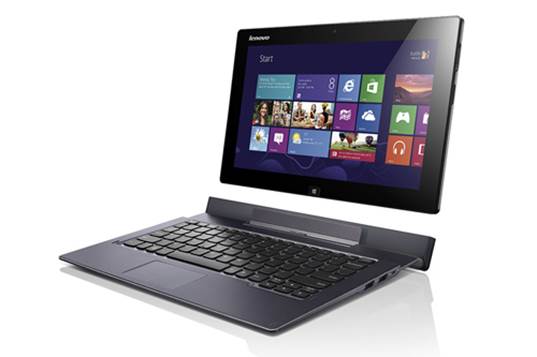If the Windows 8 tablets with Clover Trail processor
of Intel below used to be a curious thing, they’re not novel anymore. We have
seen the low-power hybrid tablets from most of the PC manufacturers, offering a
cheaper choice for the Core i5 and i7 system, but still providing useful
accessories such as keyboard dock. Besides one of our favorite tablet powered
by Atom, ThinkPad Tablet 2, Lenovo is releasing IdeaTab Lynx (which is also called
IdeaTab K3011) with the price of 549 USD and up. So how does this system
compare? Read on to find out.

Besides
one of our favorite tablet powered by Atom, ThinkPad Tablet 2, Lenovo is
releasing IdeaTab Lynx (which is also called IdeaTab K3011) with the price of
549 USD and up.
Design and feelings
IdeaTab Lynx is an uncomplicated black
tablet slab – a lightweight and thin tablet. At 1.41 pound of weight and 0.37
inch of thickness, it won’t make your hands feel heavy. It also feels good in
palm, thanks to the rough back that is interesting for grasping. Lynx can be
comfortable in hands, but the overall design is barely luxurious; the entire
packs feels like cheap plastic, and the back seems like it can be peeled off
without much effort (though it will never be). The front of the device is
completely empty except for the Lenovo branding and the 2MP front-facing camera
sitting on the top of the 11.6inch screen. Of course, the front is also the
place of the physical Windows 8 Start button, which sits on the typical
position under the screen and responds well to our press.

IdeaTab
Lynx is an uncomplicated black tablet slab – a lightweight and thin tablet.
Along the left edges of the device is the
on/off button for auto-rotating feature, volume rocker and a small speaker
grille. The top of the device has a power button and microSD card slot,
accessible by removing the plastic case. On the right side, you will find
headphone/mic jack, 1 micro-HDMI port and another small speaker while the
bottom edge of the device has micro-USB port along with the slots for
connecting optional keyboard dock. On the back of the device, the name of Lenovo
is written by the reflected silver characters, and the diamond pattern invites
your fingers to scratch it. There’s one more interesting thing: the micro-HDMI-to-VGA
adapter, allowing you to connect Lynx to the compatible screens and projector.
Keyboard dock
The optional keyboard dock (199 USD) supplements
for 2-USB 2.0-port Lynx, built-in battery and a charging port outside the
Chiclet keys. Dock is made of plastic with the gray surface, and the hinge
connecting to the dock connector can be fold down for easier storing. It adds
and extra of 1.45 pound into the tablet, delivering the total weight of 2.86
pound. The IdeaTab brand sits under the keyboard tray, and a tiny touchpad locates
underneath the long bar. Like some devices having different docks we used to
test, Lynx locks on the position when you press the button on the dock top (this
is also the way to remove the tablet). The system works smoothly – there’s
rarely a complaint here.

The
optional keyboard dock (199 USD) supplements for 2-USB 2.0-port Lynx, built-in
battery and a charging port outside the Chiclet keys.
We have some complaints related to the
keyboard. These Chiclet keys are same U-shaped smile keys we have found on Yoga
and other Lenovo devices, and while they’re spacious, the keyboard tray itself exposes
annoying curvedness. If you’re like us, you compare this keyboard to the
higher-class ones, you can feel a little disappointed because of this layout – of
course it doesn’t have ThinkPad-graded quality. In one typing test, we reached
the speed of 45 words/minutes, which were significantly lower than the average
level, and the mistaken rate was higher than normal. Dock also includes a small
touchpad, which we found extremely sophisticated. It usually have problems in
discriminating our left and right click, which means that pressing a small icon
can take several more seconds than normal.

Dock
also includes a small touchpad, which we found extremely sophisticated.